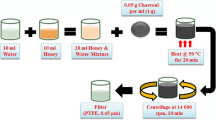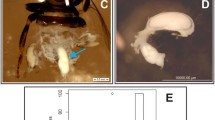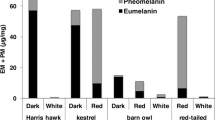Abstract
Honey bees play a crucial role in the nature by pollinating wild flowers. Over the past years, there has been an increasing concern regarding the honey bee colony decline. Pesticides or environmental effects targeting the biochemistry of insect chitin and cuticle coating may be in part responsible for honey bee pathologies. We here propose the use of electron paramagnetic resonance imaging (EPRI) as a tool to image the melanin–chitin complexes as part of the exoskeleton of the honey bee. EPRI at 9.65 GHz was applied on intact freeze-dried bees. The imaging data were collected on the melanin peak. High-resolution images revealed that this compound is extensively distributed in the periphery of the animal, data consistent with the localization in the cuticle of the bee. While EPR of melanin has been so far explored in the context of melanoma characterization, it may offer new opportunities in research on honey bees and other insects.





Similar content being viewed by others
References
Rhodes, C. J. (2018). Pollinator decline - an ecological calamity in the making? Science Progress, 101, 121–160.
Klein, S., Cabirol, A., Devaud, J. M., Barron, A. B., & Lihoreau, M. (2017). Why bees are so vulnerable to environmental stressors. Trends in Ecology & Evolution, 32, 268–278.
Butzloff, P. R. (2011). Micro-CT imaging of denaturated chitin by silver to explore honey bee and insect pathologies. PLoS ONE, 6, e27448.
Cohen, E. (1993). Chitin synthesis and degradation as targets for pesticide action. Insect Biochemistry and Physiology, 22, 245–261.
Keller, A., Brandel, A., Becker, M. C., Balles, R., Abdelmohsen, U. R., Ankenbrand, M. J., & Sickel, W. (2018). Wild bees and their nests host Paenibacillus bacteria with functional potential of avail. Microbiome, 6, 229.
Kayser, H., & Palivan, C. G. (2006). Stable free radicals in insect cuticles: electron spin resonance spectroscopy reveals differences between melanization and sclerotization. Archives of Biochemistry and Biophysics, 453, 179–187.
Kurchenko, V. P., Kukulyanskaya, T. A., Azarko, I. I., Zueva, O. Yu, Khizmatullin, R. G., & Varlamov, V. P. (2006). Physicochemical properties of chitin-melanin and melanoprotein complexes from bee corpses. Appllied Biochemistry and Microbes, 42, 331–334.
Ito, S., & Wakamatsu, K. (2008). Chemistry of mixed melanogenesis–pivotal roles of dopaquinone. Photochemistry and Photobiology, 84, 582–592.
Commoner, B., Townsend, J., & Pake, G. E. (1954). Free radicals in biological materials. Nature, 174, 689–691.
Sealy, R. C., Hyde, J. S., Felix, C. C., Menon, I. A., & Prota, G. (1982). Eumelanins and pheomelanins: characterization by electron spin resonance spectroscopy. Science, 217, 545–547.
Saifutdinov, R. G., Larina, L. I., Vakulskaya, T. I., & Voronkov, M. G. (2001). Paramagnetic centers in the human biological media. In R. G. Saifutdinov, et al. (Eds), Electron paramagnetic resonance in biochemistry and medicine (pp. 21–73). New York: Kluwer Academic/Plenum Publishers.
Enochs, W. S., Nilges, M. J., & Swartz, H. M. (1993). A standardized test for the identification and characterization of melanins using electron paramagnetic resonance (EPR) spectroscopy. Pigment Cell Research, 6, 91–99.
Sarna, T., & Swartz, H. M. (1978). Identification and characterization of melanin in tissues and body fluids. Folia Histochemica et Cytochemica, 16, 275–286.
Barek, H., Veraksa, A., & Sugumaran, M. (2018). Drosophila melanogaster has the enzymatic machinery to make the melanic component of neuromelanin. Pigment Cell & Melanoma Research, 31, 683–692.
Vanea, E., Charlier, N., Dewever, J., Dinguizli, M., Feron, O., Baurain, J. F., & Gallez, B. (2008). Molecular electron paramagnetic resonance imaging of melanin in melanomas: a proof-of-concept. NMR Biomedicine, 21, 296–300.
Plonka, P. M. (2009). Electron paramagnetic resonance as a unique tool for skin and hair research. Experimental Dermatology, 18, 472–484.
Godechal, Q., & Gallez, B. (2011). The contribution of electron paramagnetic resonance to melanoma research. Journal of Skin Cancer, 2011, 273280.
Godechal, Q., Leveque, P., Marot, L., Baurain, J. F., & Gallez, B. (2012). Optimization of electron paramagnetic resonance imaging for visualization of human skin melanoma in various stages of invasion. Experimental Dermatology, 21, 341–346.
Godechal, Q., Ghanem, G. E., Cook, M. G., & Gallez, B. (2013). Electron paramagnetic resonance spectrometry and imaging in melanomas: comparison between pigmented and nonpigmented human malignant melanomas. Molecular Imaging, 12, 218–223.
Nakagawa, K., Minakawa, S., Sawamura, D., & Hara, H. (2017). Characterization of melanin radicals in paraffin-embedded malignant melanoma and nevus pigmentosus using X-band EPR and EPR imaging. Analytical Sciences, 33, 1357–1361.
Nakagawa, K., Minakawa, S., Itabashi, C., & Sawamura, D. (2019). Investigation of paraffin-embedded basal cell carcinoma using electron paramagnetic resonance. Analytical Sciences, 35, 265–269.
Desmet, C. M., Danhier, P., Acciardo, S., Levêque, P., & Gallez, B. (2019). Towards in vivo melanin radicals detection in melanomas by electron paramagnetic resonance (EPR) spectroscopy: a proof-of-concept study. Free Radical Research, 53, 405–410.
Hyodo, F., Naganuma, T., Eto, H., Murata, M., Utsumi, H., & Matsuo, M. (2019). In vivo melanoma imaging based on dynamic nuclear polarization enhancement in melanin pigment of living mice using in vivo dynamic nuclear polarization magnetic resonance imaging. Free Radical Biology and Medicine, 134, 99–105.
Plotkin, M., Hod, I., Zaban, A., Boden, S. A., Bagnall, D. M., Galushko, D., & Bergman, D. J. (2010). Solar energy harvesting in the epicuticle of the oriental hornet (Vespa orientalis). Naturwissenschaften, 97, 1067–1076.
D’Ischia, M., Napolitano, A., Pezzella, A., Meredith, P., & Sarna, T. (2009). Chemical and structural diversity in eumelanins: unexplored bio-optoelectronic materials. Angewandte Chemie International Edition, 48, 3914–3921.
Author information
Authors and Affiliations
Corresponding author
Ethics declarations
Conflict of Interest
The authors declare that they have no conflict of interest.
Additional information
Publisher’s note Springer Nature remains neutral with regard to jurisdictional claims in published maps and institutional affiliations.
This paper was presented as a poster during the XIth International Workshop on EPR in Biology and Medicine.
Rights and permissions
About this article
Cite this article
Charlier, N., Desoil, M., Gossuin, Y. et al. Electron Paramagnetic Resonance Imaging of Melanin in Honey Bee. Cell Biochem Biophys 78, 123–126 (2020). https://doi.org/10.1007/s12013-020-00903-8
Received:
Accepted:
Published:
Issue Date:
DOI: https://doi.org/10.1007/s12013-020-00903-8




